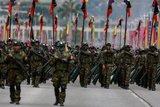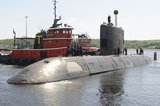Indra proposes “Internet of Underwater Things” as possible next step in naval warfare
An image of the Orca XLUUV from Boeing, one of many systems that will form a US hybrid underwater defence fleet. (Image: Boeing)
Autonomous underwater vehicles are a growing factor in naval warfare. The market for these vehicles was worth US$2 billion in 2024, and is projected to grow to twice that size by 2029. But defence technology firm Indra says a new, more connected approach may be necessary if such vehicles and systems are to be effective in seabed defence and warfare for the next generation.
Shephard spoke to Rafael Arcos Palacios, senior manager, D&S Strategy at Indra, who said the industry may need to re-think its provision of underwater uncrewed systems, with a stronger eye on real-time interoperability and communication. He
Already have an account? Log in
Want to keep reading this article?
More from Naval Warfare
-
![Will the US Navy surge production for OTH-WS missile?]()
Will the US Navy surge production for OTH-WS missile?
The USN is conducting a market search seeking additional sources capable of supplying 516 units of Over the Horizon – Weapons System Encanistered Missiles.
-
![Thales wins DE&S contract for portable autonomous command centres]()
Thales wins DE&S contract for portable autonomous command centres
The agreement to provide portable autonomous command centres to the UK Royal Navy will enhance the service’s Mine Counter Measure operations and further integrate autonomous and uncrewed systems into its fleet.
-
![Maritime defence in the Mediterranean faces challenges from vulnerable land power]()
Maritime defence in the Mediterranean faces challenges from vulnerable land power
As an indispensable energy crossroads, the Mediterranean is at serious risk from grey zone disruption. As navies increasingly employ AI data centres, what happens when cutting-edge defence technologies rely on the very infrastructure most susceptible to hybrid tactics?
-
![US Navy to conduct an experimentation campaign with emerging tech in 2026 and 2027]()
US Navy to conduct an experimentation campaign with emerging tech in 2026 and 2027
The Technology Operational Experimentation Events will inform future requirements as the US Navy looks for innovative solutions across three key operational domains.























